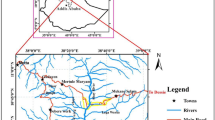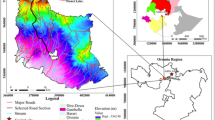Abstract
Despite the development of cities, risk assessment of rock slope stability in urban areas seems not to be growing at the same time. Mashhad is a developed city in northeast of Iran with a population of over 2.4 million. Given the closeness of the southern part of Mashhad to the Binaloud mountain ridge, the stability of the residential complexes that are being constructed in this area is a critical issue. Based on the fundamental roles of discontinuity properties and geo-mechanical parameters of rock mass, in this study we evaluated the most influential parameters of the rock slope stability and the failure probability of the slope near the Negin residential complex built on this ridge. According to the deterministic and probabilistic analyses, the north trench that was excavated for this residential complex could potentially cause plane failure. Moreover, the relationship between effective parameters on instability and their impact on safety factors were determined by sensitivity analysis. Therefore, slope dip, pore water pressure, and joint set dip were highly influential on the safety factor. There was also a nonlinear relationship between different parameters and safety in the studied area. This study presents an approach for risk assessment of rock slope stability in urban areas.











Similar content being viewed by others
References
Afshar-Harb A (1984) Geology of Kopet–Dagh region. GeolSurv Iran, 281
Alexander D (1986) Landslide damage to building. Environ Geol Water Sci 8(3):147–151
American Society for Testing and Materials (ASTM) D 2938 (2002) Standard Test Method for Unconfined Compressive Strength of Intact Rock Core Specimens. Annual Book of ASTM Standards, Vol. 4.08. United States
American Society for Testing and Materials (ASTM) D5607 (1995) Standard test method for performing laboratory direct shear strength tests of rock specimens under constant normal force. Annual Book of ASTM Standards, Vol. 4.08. United States
Brideau MA, Stead D, Kinakin D, Fecova K (2005) Influence of tectonic structures on the Hope Slide, British Columbia, Canada. Eng Geol 80:242–259
Brideau MA, Yan M, Stead D (2009) The role of tectonic damage and brittle rock fracture in the development of large rock slope failures. Geomorphology 103:30–49
Coates DF (1981) Rock mechanics principles. Energy, Mines and Resources, Canada, Monograph 874
Crozier MJ (1986) Landslide causes, consequences and environment. Croom Helm, London
Darvishzadeh A (2003) Iran geology. 3th edn. Industrial University of Amirkabir, Tehran
Donati L, Turrini MC (2002) An objective method to rank the importance of the factors predisposing to landslides with the GIS methodology: application to an area of the Apennines (Valnerina; Perugia, Italy). Eng Geol 63:277–289
Duzgun HSB, Bhasin RK (2009) Probabilistic stability evaluation of Oppstadhornet rock slope, Norway. Rock Mech Rock Eng 42:729–749
Einstein HH, Baecher GB (1982) Probabilistic and statistical methods in engineering geology. Rock Mech 12:47–61
Gattinoni P (2009) Parametrical landslide modeling for the hydrogeological susceptibility assessment: from the Crati Valley to the Cavallerizzo landslide (Southern Italy). Nat Hazard 50:161–178
Gischig V, Amann F, Moore JR et al (2011) Composite rock slope kinematics at the current Randa instability, Switzerland, based on remote sensing and numerical modeling. Eng Geol 118:37–53
Goodman RE (1989) Introduction to rock mechanics, 2nd edn. Wiley, New Jersey
Goodman RE, Kieffer DS (2000) Behavior of rock in slopes. J GeotGeoenEng 126:675–684
Grenon M, Hadjigeorgiou J (2008) A design methodology for rock slopes susceptible to wedge failure using fracture system modeling. Eng Geol 96:78–93
Hoek E (2007) Practical rock engineering. Rocscience,Hoek’s Corner
Hoek ET, Bray JW (1981) Rock slope engineering, 3rd edn. The Institut of Mining and Metallurgy, London
Holub M, Suda J, Fuchs S (2011) Mountain hazards: reducing vulnerability by adapted building design. Environ Earth Science. doi:10.1007/s12665-011-1410-4
Hudson JA, Harrison JP (1997) Engineering rock mechanics. Pergamon, London
International Society for Rock Mechanics (ISRM) (1978) Commission on standardization of laboratory and field tests: suggested methods for the quantitative description of discontinuities in rock masses. Int J Rock Mechan Min Sci Geomechan Abs 15:319–368
Li D, Zhou C, Lu W, Jiang Q (2009) A system reliability approach for evaluating stability of rock wedges with correlated failure modes. Comput Geotech 36:1298–1307
O’Hare G, Rivas S (2005) The landslide hazard and human vulnerability in La Paz City Bolivia. Geogr J 171(3):239–258
Papini M., Granito A, Scesi L. (1998) Geomechanical characterization of rock masses: a statistical approach. In: Proceedings of the IAMG 4th annual conference (Ischia, Italy), pp 845–850
Pariseau WG, Puri S, Schmelter SC (2008) A new model for effects of impersistent joint sets on rock slope stability. Int J Rock Mech Min Sci 45:122–131
Park H, West TR (2001) Development of a probabilistic approach for rock wedge failure. Eng Geol 59:233–251
Pathak S, Nilsen B (2004) Probabilistic rock slope stability analysis for Himalayan condition. Bull EngGeolEnv 63:25–32
Pentz DL (1981) Slope stability analysis techniques incorporating uncertainty in the critical parameters. Third international conference on stability in open pit mining, Vancouver, Canada
Ping F (1997) Probabilistic treatment of the sliding wedge. Department of Civil and Geological Engineering, University of Manitoba Winnipeg, Canada
Piteau DR (1972) Engineering geology considerations and approach in assessing the stability of rock slopes). Bull Assoc Eng Geol 9:301–320
Piteau DR, Martin DC (1977) Slope stability analysis and design based on probability techniques at Cassiar Mine. CIM Bull 139–150
Regmi AD, Yoshida K, Nagata H et al (2013) The relationship between geology and rock weathering on the rock instability along Mugling–Narayanghat road corridor, Central Nepal Himalaya. Nat Hazards 66:501–532
Savely JP (1987) Probabilistic analysis of intensely fractured rock masses. Sixth International Congress on Rock Mechanics, Montreal, Canada, pp 509–514
Sharma RK, Mehta BS, Jamwal CS (2013) Cut slope stability evaluation of NH-21 along Nalayan-Gambhrola section, Bilaspur district, Himachal Pradesh, India. Nat Hazards 66:249–270
Singh VK (2006) Slope stability study for optimum design of an opencast project. J Sci Ind Res 65:47–56
Singh TN, Gulati A, Dontha L, Bhardwaj V (2008) Evaluating cut slope failure by numerical analysis—a case study. Nat Hazards 47:263–279
Tabba MM (1984) Deterministic versus risk analysis of slope stability. Proceedings of fourth international symposium on landslides. Toronto, Canada, pp 491–498
Vanmarcke EH (1980) Probabilistic analysis of earth slopes. Eng Geol 16:29–50
Wyllie DC, Mah CW (2004) Rock slope engineering—civil and mining, 4th edn. Spon Press, New York
Zangerl C, Prager C (2008) Influence of geological structures on failure initiation, internal deformation and kinematics of rock slides. In: Proceeding of the 42nd US. Rock Mechanics Symposium, San Francisco, ARMA 08-063, pp 1–13
ZareNaghadehi M, Jimenez R, KhaloKakaie R, Jalali SME (2011) A probabilistic systems methodology to analyze the importance of factors affecting the stability of rock slopes. Eng Geol 118:82–92
Zhang J, Jiao JJ, Yang J (2000) Insitu rainfall infiltration studies at a hillside in Hubei Province, China. Eng Geol 57:31–38
Acknowledgment
This work was supported by grant from Ferdowsi University of Mashhad Research department.
Author information
Authors and Affiliations
Corresponding author
Rights and permissions
About this article
Cite this article
Vatanpour, N., Ghafoori, M. & Talouki, H.H. Probabilistic and sensitivity analyses of effective geotechnical parameters on rock slope stability: a case study of an urban area in northeast Iran. Nat Hazards 71, 1659–1678 (2014). https://doi.org/10.1007/s11069-013-0982-6
Received:
Accepted:
Published:
Issue Date:
DOI: https://doi.org/10.1007/s11069-013-0982-6




